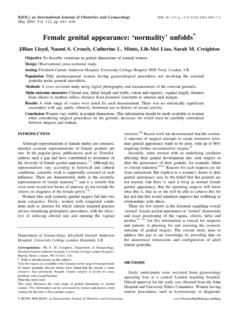Transcription of VALUE BASED COMMISSIONING POLICIES (formerly known as ...
1 1 VALUE BASED COMMISSIONING POLICIES (formerly known as Procedures of Limited Clinical VALUE POLICIES ) VERSION 31 in use from April 20182 Changes for version 31 Note please refer to Appendix for changes prior to Version 31 Varicose veins Slight change of wording to the first referral criteria bleeding veins to more clearly identify this Hernia repair in adults New COMMISSIONING guidance incorporated for groin hernia, also use of activities for daily living criteria to identify significant functional impairment Bariatric surgery Remove the criteria for BMI 50 plus for referral to tier 4 services Primary hyperhidrosis treatment Section re-written to give referral criteria from primary care to a specialist dermatology service and also shows the treatment pathway for the specialist service Tonsillectomy Slight change in the layout of bullet points to clarify criteria Hip and knee replacement Wording slightly updated and a further exception added to the exceptions allowing surgery Autologous cartilage transplantation of the knee New criteria for identifying when this option can be considered have been included Carpal Tunnel Syndrome Wording slightly
2 Modified to clarify criteria Ganglion The need for a diagnostic ultrasound has been removed from the criteria Knee arthroscopy Criteria for therapeutic arthroscopy have been updated Arthroscopic Shoulder surgery Evidence updated and wording slightly modified to clarify criteria Joint injections site of procedure This section has been removed from the policy as there are no criteria or codes related to it Joint Injections for Axial (non-radicular) Back Pain of suspected Facet Joint or sacroiliac joint origin This section has been renamed and criteria updated Trigger Point Injections including Botulinum Toxin (Botox) and Acupuncture/ Electro-acupuncture This is new section for this edition which was previously included in older editions Hysterectomy +/- Oophrectomy Typo corrected Mirena Coils Clarification of when the VBC applies Cataract surgery Wording updated to clarify where acuity does and does not apply Skin Lesions, Cysts, etc.
3 This policy has been completely updated, including a recent new section for chondrodermatitis nodularis helicis Complementary therapies Section updated to remove permission for any complementary therapies, including acupuncture Hyperbaric oxygen therapy Reference to the CCG funding where there is theoretical basis for use has been removed 3 Contents Changes log version 31 02 1. INTRODUCTION 05 2. GENERAL surgery Varicose Veins 07 Haemorrhoidectomy 07 Hernia Management and Repair in Adults 07 Bariatric surgery 09 Circumcision 09 surgery for Gallstones 10 Venous Angioplasty for Multiple Sclerosis 10 Primary Hyperhidrosis Treatment 10 3. ENT Insertion of Grommets 12 Snoring 12 Tonsillectomy 12 Removal of Ear Wax 13 4.
4 MUSCULO-SKELETAL HEALTH Hip and Knee Replacement surgery 14 Hip Resurfacing Techniques (primary resurfacing arthroplasty of joint) 14 Femeroacetabular Impingement Syndrome 15 Bunion surgery 15 Carpal Tunnel Syndrome 15 Dupuytren's Disease 16 Trigger Finger 16 Ganglion 16 Knee Arthroscopy 17 Autologous Cartilage Transplantation 17 Subacromial Decompression and/or Excision of Acromioclavicular Joint 17 Spinal Fusion for Chronic Low Back Pain 18 5. PAIN Facet Joint Injections for Axial (non-radicular) Back Pain of suspected Facet Joint origin 19 Epidural Injections for Radicular Back Pain ( Sciatica ) 20 Trigger Point Injections including Botulinum Toxin (Botox) and Acupuncture/Electro-acupuncture 21 Spinal Cord Stimulation for Chronic Pain 21 6.
5 UROLOGICAL- GENITARY PROBLEMS Treatment for Erectile Dysfunction 22 Dilatation And Curettage for Menorrhagia 22 Hysteroscopy for Menorrhagia 23 Hysterectomy +/- Oophrectomy 23 Mirena Coils 23 Reversal of Female Sterilisation 23 Reversal of Male Sterilisation 23 IVF 24 4 Routine Doppler Ultrasound Of Umbilical + Uterine Artery In Antenatal Care 24 7. EYE PROBLEMS Laser surgery for Short Sight (Myopia) 25 Cataract surgery 25 8. AESTHETIC surgery Abdominoplasty or Apronectomy 26 Thigh Lift, Buttock Lift and Arm Lift, Excision of Redundant Skin or Fat 26 Liposuction 27 Breast Augmentation 27 Breast Asymmetry 27 Breast Lift (Mastopexy) 28 Breast Reduction 28 Revision Mammoplasty (including prosthesis removal or replacement) 28 Inverted Nipple Correction 28 Male Breast Reduction surgery for Gynaecomastia 29 Labial Trimming and Cosmetic Genital Procedures 29 Labiaplasty 29 Vaginoplasty 29 Hymenorrhaphy 29 Pinnaplasty 29 Blepharoplasty 30 Face Lift or Brow Lift 30 Hair Depilation (Hair removal)
6 30 Hair Grafting - male pattern baldness 30 Removal of Tattoos 30 Removal of Benign Skin Lesions 30 Removal of Lipomata 31 Repair of Lobe of External Ear (Split earlobes) 31 Resurfacing Procedures: Dermabrasion, Chemical Peels and Laser Treatment 32 Rhinoplasty 32 Scars and Keloids 32 Botox Injection for the Ageing Face 32 Congenital Vascular Lesions 32 Anal Skin Tag Removal 32 9. NEUROLOGY/NEUROSURGERY Inpatient Neuro-Rehabilitation 33 10. MENTAL HEALTH Therapeutic Community Method Treatment for Borderline Personality Disorder 33 11. MISCELLANEOUS Inpatient Cognitive Behavioural Therapy 33 Complementary Medicines/Therapies 33 Hyperbaric Oxygen Therapy 33 Changes log prior to version 31 34 5 Introduction Since the CCG operates within finite budgetary constraints the policy makes explicit the need for the CCG to prioritise resources and provide interventions with the greatest proven health gain.
7 The intention is to ensure equity and fairness in respect of access to NHS funding. To do this, the policy provides the list of interventions not routinely funded by the CCG and the specified criteria required for the funding of certain other interventions. Please note that the policy guidance relating to these interventions should be read with reference to the principles detailed below. Commissioners, general practitioners, service providers and clinical staff treating residents of Shropshire are expected to implement this policy. When interventions are undertaken on the basis of meeting criteria specified within the policy, this should be clearly documented within the clinical notes. Failure to do so will be considered by the CCGs as lack of compliance.
8 The CCGs explicitly recognise that for each of the interventions listed in this policy there may be exceptional clinical circumstances in which the CCG would consider the funding of these interventions. It is not feasible to consider every possible scenario within this document. In cases where specified criteria are not met, applications may be considered on an individual basis through an Individual Funding Request (IFR) process. The IFR policy for Shropshire is available at In considering individual cases the CCG applies following definition of exceptionality: Where care is not routinely funded by the respective CCG, evidence must be provided to show that the patient is significantly different to the population of patients with similar clinical needs who would also not be offered the treatment This should include evidence that the patient is likely to gain significantly more benefit from the treatment than would be expected for other patients not currently offered it Exceptional clinical circumstances are defined as referring to a patient who has clinical circumstances which, taken as a whole, are outside the range of clinical circumstances presented by a patient within the normal population of patients with the same medical condition and at the same stage of progression as the patient.
9 In making a case, therefore, the clinician must specify how this patient is clinically different from others currently excluded from treatment - either in reference to the clinical picture, the expected benefit, or both. If patients choose to privately fund an intervention that is not normally funded by the CCG, they will retain their entitlement to other elements of NHS care. For example, if they privately fund a cancer drug or cancer intervention not normally funded by the CCG they will retain their entitlement to all the other elements of cancer care that other residents of Shropshire receive free of charge. However when patients are privately funding an intervention, they are responsible for all the costs associated with that intervention, including Consultant costs and diagnostics.
10 They are therefore unable to receive a mixture of privately funded and the CCG s funded care within the same appointment or intervention in line with national guidance, they cannot top-up a CCG s funded appointment or intervention by paying for an additional intervention to be provided or monitored during the same consultation. The relevant CCG POLICIES can be found on the CCG website in the COMMISSIONING section. 6 This policy will be kept under regular review, to ensure that it reflects developments in the evidence base regarding clinical and cost effectiveness. All efforts will be made to work with our main service providers to jointly review and update the policy. Unless providers are notified otherwise, implementation of the policy will continue to be monitored by the Prior Approvals process, selected audit of interventions against the criteria and by the application of procedures within the Referral Assessment Service (RAS) for Shropshire patients Implementation will be supplemented by continual monitoring of activity against the interventions.


